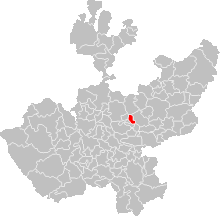Tonalá, Jalisco
| Tonalá | |
|---|---|
 |
|
| Coat of Arms | |
| Location | |
 Location in the State of Jalisco |
|
| Administration | |
| Country | Mexico |
| State | Jalisco |
| Region | Región Centro |
| Metropolitan Area | Guadalajara Metropolitan Area |
|
Municipality • Neighborhoods |
Tonalá 193 |
| Mayor | Jorge Arana Arana (2012–2015) |
| Political party | PRI |
| Geography | |
| City Area | 119.6 km² |
| Metro Area | 500 km² |
| Elevation | 1540 Mts |
| Coordinates : | 20°37′N 103°14′W / 20.617°N 103.233°W |
| Population | |
| City Population (2005) | 374,258 city; 408,729 municipality |
| Metro Population (2005) | 4,095,853 (Rank 2) |
| City Density | 3,784/km² |
| Metro Density | 8,200/km² |
| General Information | |
| Demonym | Tonalteca |
| Time Zone | CST (UTC-6) |
| • Summer | CDT (UTC-5) |
| Postal Code | 45400–45429 |
| Area Code | +52 (Mexico) / +33 (Jalisco) |
| Website – H. Ayuntamiento de Tonalá | |
Tonalá (Spanish pronunciation: [tonaˈla]) is a city and municipality within the Guadalajara Metropolitan Area in the state of Jalisco in Mexico. With a population of 374,258, it is the fourth largest city in the state, the other three being the other major population centres in the metro area: Guadalajara, Zapopan, and Tlaquepaque. It is best known as a major handcrafts center for Jalisco, especially pottery, as well as its very large Thursday and Sunday street market, dedicated to handcrafts.
The “municipal palace” or local government building is distinguished by its clock tower and arches, which are decorated in ceramic tiles in traditional motifs. There are also ceramic murals created by Salvador Vázquez and Francisco Basulto. In 2013, the local government opened an exhibition hall and museum in the building called the Tonalá Puebla-Museo, to promote local handcrafts, arts and culture.
The main church for the city is the Santiago Apostol Parish. Constructed in the 16th century, it is the second oldest standing church in the Valley of Atemajac. It is best known as the site of the masked Dance of the Tastoanes, performed in honor of Saint James on July 25. The atrium of the church as a monument to Pius IX, created in 1887. The facade of the church is of sandstone; the sides have buttresses decorated in vegetative motifs and one side has a medallion with an anagram and the date of March 24, 1813 and lion gargoyles. The main entrance is flanked by pilasters that support a frieze. Above this is the choir window framed in vegetation in relief topped by a niche. There is a single bell tower with two levels. The interior consists of three naves and vaulted ceiling, with a Neo Classical main altar.
Capilla de la Cruz Blanca (White Cross Chapel) is where the first mass in western Mexico was said in 1530 by Franciscan monks. The exterior is sober, made of stone and the facade has two small bell towers. The interior contains murals that represent the native flora and fauna of the area. The Santuario del Sagrado Corazón (Sacred Heart Sanctuary) was built in the 19th century in Gothic style over what was the Nuestra Señora de la Soledad Hospital. The interior feature a very large oil painting of “Via Crucis” depicting the stations of the cross. The San Gaspar Parish dates from the 16th century, named in honor of one of the Three Kings. Another 16th century parish is Purisima Concepción.
...
Wikipedia
